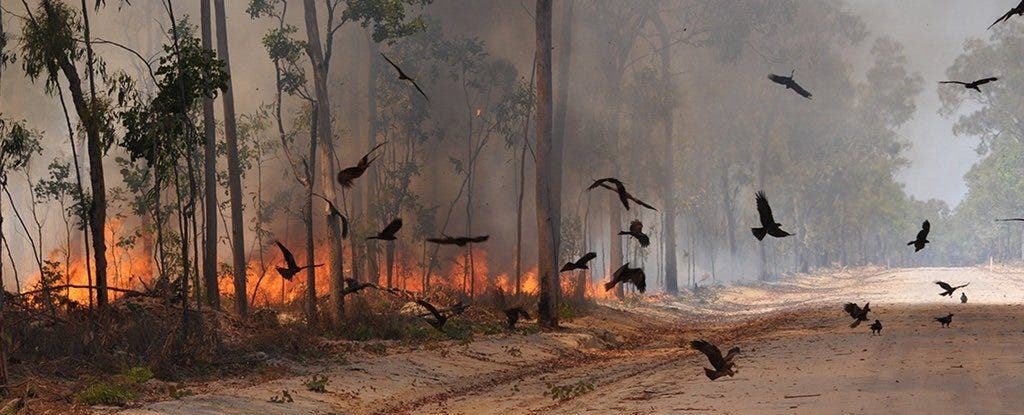Fire is supposed to be uniquely human, but that’s no longer the case. Researchers have confirmed ancient aboriginal legends: certain birds of prey in Australia spread wildfire in order to scare off, and ultimately hunt their prey in a feeding frenzy.

Dick Eussen thought he’d finally managed to put down the fire. He had it cornered, behind the side of a highway deep in the Australian outback. Eussen, a veteran firefighter in Australia’s Northern Territory, was convinced the fire couldn’t jump to the other side. He’d seen similar things in the past, and they never jumped. But this time, it did.
Eussen rushed to the other side to quench the flames, still surprised by how unexpectedly the fire jumped. Looking for answers, he looked up. Like a dark spirit, a whistling kite flew in the sky, a burning twig in its talons. After about 20 meters, it dropped the twig and the flames started again.
In total, there were seven flare-ups that day. By the end of it all, Eussen was exhausted and puzzled.

Australia is no stranger to extreme heat, and it’s no stranger to fire. Year after year, bushfires devastate vast swaths of land, destroying ecosystems and posing a huge threat to any nearby creatures, be they animal or human. But for some, bushfires can be a godsend. A new study reports that at least three bird species — the Black Kite (Milvus migrans), Whistling Kite (Haliastur sphenurus), and Brown Falcon (Falco berigora) — not only use, but also intentionally spread wildfires for their own purposes. The birds were spotted carrying burning twigs, as well as placing new ones into the flames, only to pick them up again and spread the fire.
“Observers report both solo and cooperative attempts, often successful, to spread wildfires intentionally via single-occasion or repeated transport of burning sticks in talons or beaks. This behavior, often represented in sacred ceremonies, is widely known to local people in the Northern Territory, where we carried out ethno-ornithological research from 2011 to 2017.”
For the raptors, this creates a feeding frenzy, an all-you-can-eat buffet. Groups of desperate creatures flee the burning areas, leaving the safety of the tree cover and running into the open, where they’re easy prey.
Co-author Bob Gosford, an Australian indigenous-rights lawyer turned biologist, says the birds have a lot to win from this behavior.
“Black kites and brown falcons come to these fronts because it is just literally a killing frenzy,” he said in a 2016 interview with the Australian Broadcasting Corporation. “It’s a feeding frenzy, because out of these grasslands come small birds, lizards, insects, everything fleeing the front of the fire.”
“Intentional Fire-Spreading by “Firehawk” Raptors in Northern Australia,” Bonta et al. Journal of Ethnobiology, 37(4) (abstract): https://t.co/JJVomc5zDy #ethnobiology #ethnoornithology #birds #fire pic.twitter.com/Bv4oSA6BpC
— Bob Gosford (@bgosford) January 1, 2018
But while this finding is thrilling for biologists, it isn’t actually representing newly observed behavior. This behavior has been described before.
“I have seen a hawk pick up a smouldering stick in its claws and drop it in a fresh patch of dry grass half a mile away, then wait with its mates for the mad exodus of scorched and frightened rodents and reptiles,” wrote Waipuldanya Phillip Roberts in I, the Aboriginal, a 1964 autobiography of Roberts compiled by Australian journalist Douglas Lockwood.
“When that area was burnt out, the process was repeated elsewhere.”
Aboriginal peoples have observed this behavior for millennia, and even feature it in ritualistic ceremonies. The indigenous people of the Northern Territory have long claimed that a group of birds they call “firehawks” can control fire by spreading burning sticks.
“We’re not discovering anything,” cautions co-author Mark Bonta, a National Geographic grantee and geographer at Penn State University. “Most of the data that we’ve worked with is collaborative with Aboriginal peoples… They’ve known this for probably 40,000 years or more.”
However, such tales are often unreliable and having a proper scientific description paves the way for a proper understanding of the behavior. Also, there was a theory that in the frenzy, the birds of prey mistakenly grab twigs, and when they realize their mistake, they drop them. This study demonstrates a clear intention to spread the wildfire.
Gosford and his colleagues encourage people to send them photos or videos of this behavior to better understand the process, but they haven’t had much success so far.
Understanding these arsonist birds is important not only from a biological perspective, but also considering fire safety. Aside from humans and lightning, there’s a new culprit which spreads wildfires — one with wings instead of hands. Hopefully, new research will establish how much of an impact these birds have.
Journal Reference: Mark Bonta, Robert Gosford, Dick Eussen, Nathan Ferguson, Erana Loveless, and Maxwell Witwer. Intentional Fire-Spreading by “Firehawk” Raptors in Northern Australia. https://doi.org/10.2993/0278-0771-37.4.700


